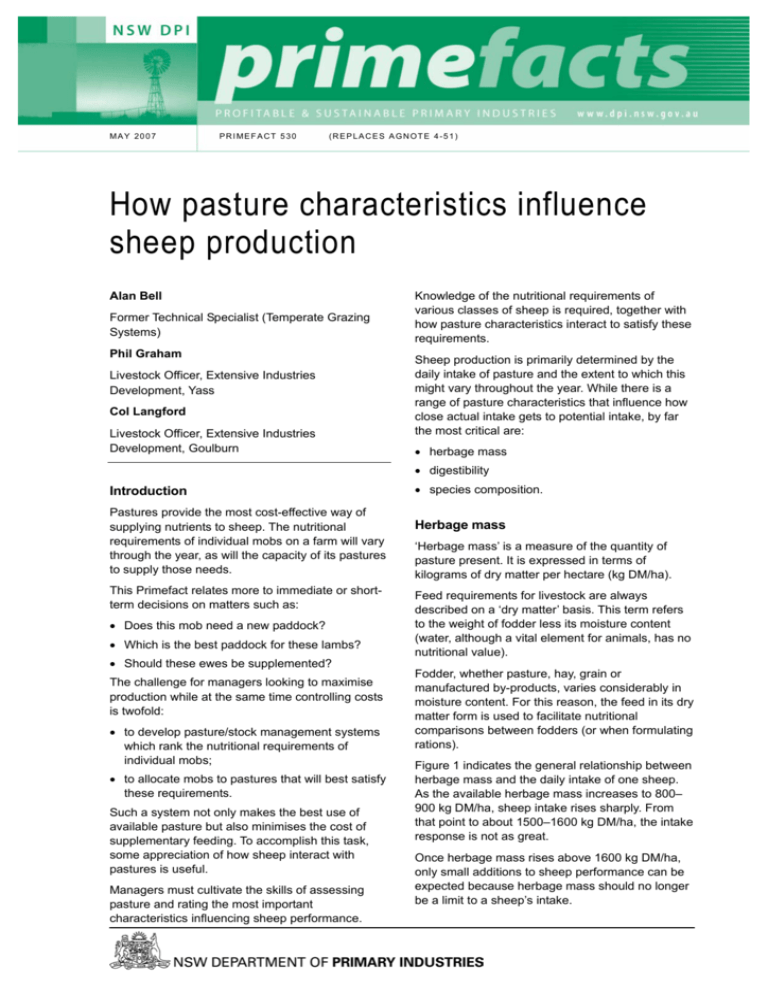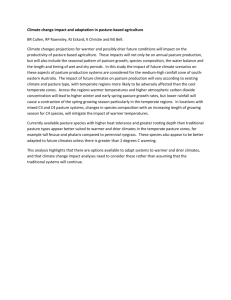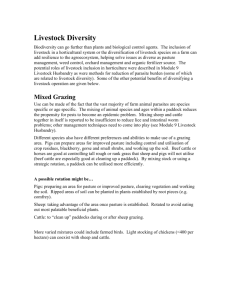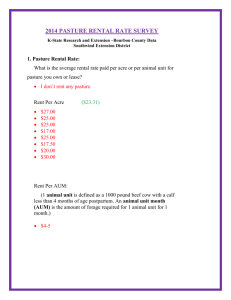How pasture characteristics influence sheep production
advertisement

MAY 2007 PRIMEFACT 530 (REPLACES AGNOTE 4-51) How pasture characteristics influence sheep production Alan Bell Former Technical Specialist (Temperate Grazing Systems) Phil Graham Livestock Officer, Extensive Industries Development, Yass Col Langford Livestock Officer, Extensive Industries Development, Goulburn Knowledge of the nutritional requirements of various classes of sheep is required, together with how pasture characteristics interact to satisfy these requirements. Sheep production is primarily determined by the daily intake of pasture and the extent to which this might vary throughout the year. While there is a range of pasture characteristics that influence how close actual intake gets to potential intake, by far the most critical are: • herbage mass • digestibility Introduction Pastures provide the most cost-effective way of supplying nutrients to sheep. The nutritional requirements of individual mobs on a farm will vary through the year, as will the capacity of its pastures to supply those needs. This Primefact relates more to immediate or shortterm decisions on matters such as: • Does this mob need a new paddock? • Which is the best paddock for these lambs? • Should these ewes be supplemented? The challenge for managers looking to maximise production while at the same time controlling costs is twofold: • to develop pasture/stock management systems which rank the nutritional requirements of individual mobs; • to allocate mobs to pastures that will best satisfy these requirements. Such a system not only makes the best use of available pasture but also minimises the cost of supplementary feeding. To accomplish this task, some appreciation of how sheep interact with pastures is useful. Managers must cultivate the skills of assessing pasture and rating the most important characteristics influencing sheep performance. • species composition. Herbage mass ‘Herbage mass’ is a measure of the quantity of pasture present. It is expressed in terms of kilograms of dry matter per hectare (kg DM/ha). Feed requirements for livestock are always described on a ‘dry matter’ basis. This term refers to the weight of fodder less its moisture content (water, although a vital element for animals, has no nutritional value). Fodder, whether pasture, hay, grain or manufactured by-products, varies considerably in moisture content. For this reason, the feed in its dry matter form is used to facilitate nutritional comparisons between fodders (or when formulating rations). Figure 1 indicates the general relationship between herbage mass and the daily intake of one sheep. As the available herbage mass increases to 800– 900 kg DM/ha, sheep intake rises sharply. From that point to about 1500–1600 kg DM/ha, the intake response is not as great. Once herbage mass rises above 1600 kg DM/ha, only small additions to sheep performance can be expected because herbage mass should no longer be a limit to a sheep’s intake. Species composition ‘Species composition’ refers to the presence and proportion of species in the pasture. The important aspect from a practical point of view is the proportion of total legume in the pasture. Figure 1. The relationship between herbage mass and sheep intake. Digestibility Digestibility is the most useful measure of pasture quality. ‘Digestibility’ refers to the proportion of a feed an animal can use to satisfy its nutritional requirements. Digestibility is directly related to the energy content of the feed and has a positive relationship with protein. This means that a pasture with a digestibility of 70–80% will have energy and protein levels capable of supporting high levels of sheep performance. On the other hand, a pasture of lower digestibility (55%) has energy levels capable of little more than maintaining the liveweight of dry sheep. In these circumstances, the protein is usually sufficient to balance the energy level (and therefore is adequate for that quality of diet). Pasture maturity has the biggest influence on its digestibility. Table 1 shows how the digestibility of phalaris declines with its maturity. Similar trends occur in other pasture species. Pasture below 50% digestibility will not maintain any class of sheep. Table 1. Effect of maturity of phalaris on its digestibility Stage of maturity Digestibility (%) Early vegetative 80 Late vegetative 74 Mid-flower 63 Late flower 42 Mature 38 Digestibility of pasture also influences a sheep’s daily intake. A diet that is more digestible than another spends less time in the stomach, thereby encouraging a sheep to eat more to satisfy its appetite. The more nutrients consumed, the closer a sheep will come to achieving its genetic potential for growth or wool production. In general, at the same rate of digestibility, sheep will consume a greater quantity of legume than grass. Sheep will also tend to select legume before grass. In circumstances where high performance is required, for example lactating ewes or finishing lambs, a legume content of at least 30% should be the objective. Palatability and smell are other characteristics that influence intake, as is the preference sheep have for one species over another. Apart from the general preference for legume compared with grass, other factors thought to influence preference include a plant’s physical characteristics such as an upright growth habit compared with a prostrate growth habit, and leafiness compared with a high proportion of stem. While recognising the existence of these characteristics, herbage mass, digestibility and species composition are by far the most important factors in predicting a pasture’s immediate or shortterm animal production potential. Preference has important implications for the longterm stability of the pasture. Highly preferred species are usually selectively grazed and this can reduce or even eliminate these species from the pasture. For example, the grazing pressure of continual set stocking* (an area that is continuously grazed throughout the year, usually by the same type of stock. Such paddocks are not spelled.) can reduce the presence of preferred species due to the limited opportunity that plants have to recover following a stress period. Managers should be aware of circumstances that place plant species at risk and should implement grazing procedures that ensure the long-term stability of the pasture. Herbage mass and digestibility interaction Throughout the year the shifting pattern of climatic change influences pasture quantity and quality. Within this annual spectrum, clearly defined seasonal characteristics do exist for both digestibility and herbage mass, but the patterns for each need not necessarily coincide. Digestibility may be high when herbage mass is low, and vice versa. When managing the nutritional needs of sheep there can, in some circumstances, be a trade-off between digestibility and herbage mass. The ability of management to make use of trade-offs depends on the type of stock. For instance, lactating ewes or PRIMEFACT 530, HOW PASTURE CHAR ACTERISTICS INFLUENCE SHEEP PRODUCTION 2 Figure 2. Pasture benchmarks ewes in late pregnancy are much less flexible than are adult dry stock. Figure 2 shows the interaction between digestibility and herbage mass across various sheep classes and provides benchmarks for differing production levels. Providing sheep with pasture of higher quantity or quality is likely to result in improved levels of production. There will be occasions when the benchmarks in Figure 2 will not be met. For example, ewes can still lose weight during the peak of lactation when they are suckling twins. This does not necessarily mean that supplementary feeding is necessary. Management has the option of using the sheep’s capacity to store fat reserves in the good times and to mobilise these reserves when pastures cannot fully supply its nutritional requirements. To be able to utilise this capacity, sheep must attain sufficient liveweight or fat reserves prior to seasonal declines in pasture production or before high nutritional demand periods occur, for example prior to lactation. The benchmarks described in Figure 2 have been devised with the nutritional needs of sheep being the sole criteria. Grazing management also needs to consider the long-term stability of both pasture and soil, and the maximising of pasture production. Excessively high or low stocking rates and the pattern of grazing pressure will be important influences on stability and pasture production. Fortunately there is complementarity between the herbage mass required to achieve maximum sheep production and that required for pasture growth. As green herbage mass declines below about 1000 kg DM/ha, leaf area begins to limit growth. As herbage increases above 3000 kg DM/ha, shading by the leaf mass has the same effect of limiting growth. Effect of stocking rate on pasture benchmarks Pasture benchmarks (Figure 2) hold true regardless of stocking rate. The stocking rate will influence how long a pasture can be maintained at PRIMEFACT 530, HOW PASTURE CHAR ACTERISTICS INFLUENCE SHEEP PRODUCTION 3 any given herbage mass. If the stocking rate is such that the amount of pasture being consumed is greater than its growth, herbage mass will decline and the risk is that it will drop below a desired benchmark. If a paddock is grazed below these benchmarks then sheep production is likely to suffer. This lower production level can be accepted (and this can often be the appropriate management decision), or stock can be moved to a more suitable paddock, or supplements can be fed. Assessing herbage mass When eyeballing a pasture to predict herbage mass, the components needing consideration include height, density, an assessment of moisture content and clover content. Care must be taken when assessing pastures with a high subclover content. The reason for this is that while there is a tendency to overestimate the herbage mass, underestimation is inclined to occur with very dense subclover pasture. From Figure 2 the critical herbage mass benchmarks are in the range 400–1600 kg DM/ha. Over this range, pasture assessment skills can be developed quickly. It involves taking pasture cuts, weighing these and drying a sample (usually in a microwave oven) to obtain dry matter. A description of the technique can be obtained from a livestock officer (sheep and wool) from NSW Department of Primary Industries, or a PROGRAZE course can be undertaken. Pasture height, on its own, can be used as a rough guide to herbage mass. Table 1 provides an indication of that relationship. The heights referred to apply to a dense grass/legume pasture prior to flowering and with little dead herbage. Conclusion Pasture characteristics have the most influence on a sheep’s daily intake and therefore on sheep production. Recognition of these characteristics and their incorporation into grazing management strategies is important in improving the efficiency of sheep-grazing systems. By using predictions of pasture growth rate and actual intake, managers are able to relate decision making to stocking rates, fodder budgeting and feed profiling. The aim of the last two aspects is to achieve the most appropriate fit between pasture production and the farm’s livestock enterprises. In southern and central NSW critical herbage masses are experienced during late autumn to early spring. From late summer to the autumn break, pasture digestibility is the most limiting factor. Individual producers need to select the production level that they are prepared to accept. If stocking rates cause pasture mass to fall below these benchmarks continually, then supplementary feeding is required to ensure satisfactory animal production and welfare. Acknowledgment The authors would like to acknowledge the help of the GrazFeed® computer program in providing the benchmarks that appear in this Primefact. © State of New South Wales through NSW Department of Primary Industries 2007. You may copy, distribute and otherwise freely deal with this publication for any purpose, provided that you attribute NSW Department of Primary Industries as the owner. ISSN 1832-6668 Replaces Agnote 4-51 Table 1. Relationship between pasture height and herbage mass. Approximate pasture Green herbage mass (kg height (cm) DM/ha) 1.0–1.5 400–600 2.0–2.5 800–1000 4.0–5.0 1400–1600 Check for updates of this Primefact at: www.dpi.nsw.gov.au/primefacts Disclaimer: The information contained in this publication is based on knowledge and understanding at the time of writing (May 2007). However, because of advances in knowledge, users are reminded of the need to ensure that information upon which they rely is up to date and to check currency of the information with the appropriate officer of New South Wales Department of Primary Industries or the user’s independent adviser. Job number 7448 PRIMEFACT 530, HOW PASTURE CHAR ACTERISTICS INFLUENCE SHEEP PRODUCTION 4









